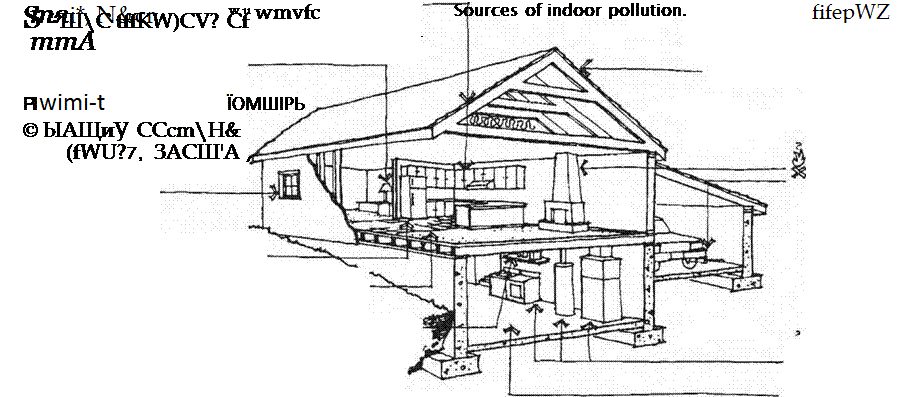Sources of Indoor Pollution
Indoor air pollutants can be classified into five main categories: volatile organic compounds, toxic byproducts of combustion, pesticides, electromagnetic fields, and naturally occurring pollutants. Each category of pollutant is described in a following section.
|
h ’ЇЇІЖггі C%MY6 /м ЙЗДМеьт Шіь, * гииш FZti&vWTiat* |
 |
Organic compounds are chemicals containing carbon-hydrogen bonds at the molecular level. They are both naturally occurring and
manufactured. Most synthetic organic compounds are petrochemicals derived from oil, gas, and coal. Organic compounds can exist in the form of a gas, a liquid, or solid particles. Substances that readily release vapors at room temperature are called volatile organic compounds (VOCs). This outgassing is a form of evaporation of volatile compounds contained in solid material and results in a slow release of chemicals into the air.
VOCs constitute a major source of toxic overload and can threaten individual health. Any organ of the body can be affected. Some of the more common symptoms include rashes, headaches, eye irritation, chronic cough, chronic sinus infections, joint and muscle pain, memory loss, inability to concentrate, irritability, fatigue, anxiety, depression, and an increasing number of allergies.
Organic compounds can be classified into three categories based on derivation from petroleum products. The primary organic compounds include components directly derived from gas, oil, and coal and include propane, butane, benzene, xylene, paraffins, toluene, and styrene. These products are then used to derive the intermediate substances such as formaldehyde, phenols, acetone, isopropanol, and acetaldehyde. The end products produced include solvents, waxes, lacquers, synthetic detergents, synthetic fibers, and paints. Common sources of volatile organic compounds occurring in the indoor environment include:
• plywood
• particleboard
• wood paneling
• carpets and carpet pads
• insulation
• paints
• finishes
• solvents
• adhesives
• synthetic fabrics
• cleaning products
• body care products
• mothballs
• insecticides
• aerosol products
• art and hobby materials
• dry cleaned garments
• air fresheners
VOCs can also be generated from natural substances. These include terpenes, which outgas from wood, and aromatics from natural oils. Some more chemically sensitive individuals react to naturally occurring VOCs. These individuals are urged to test their reactions to each product before making a major purchase, even if the product is derived from a natural source.
You are undoubtedly familiar with the distinctive smell of a new house. The odor is composed primarily of outgassing chemicals from toxic volatile organic compounds. Some building products now report the parts per million of VOCs on their labels, but this information can be misleading. Yes, it is true that the fewer parts per million the better, but certain chemicals such as dioxin are not safe in any detectable amount.1 One of the goals in constructing a healthy house is to reduce the use of toxic VOCs.






Leave a reply